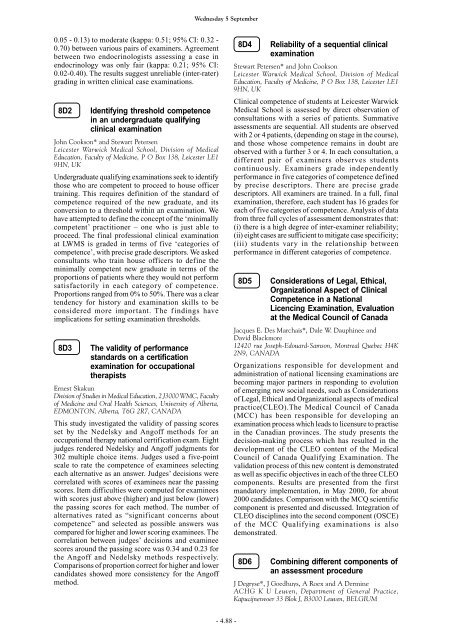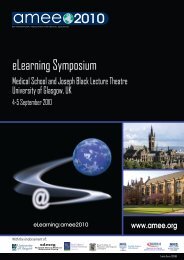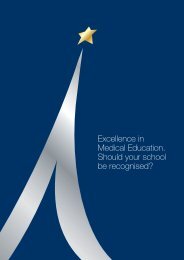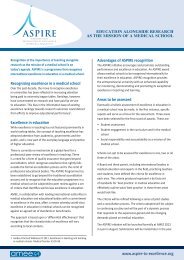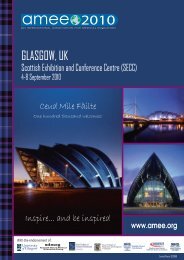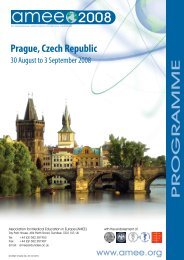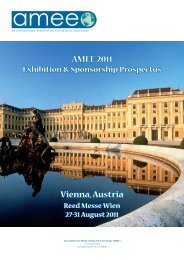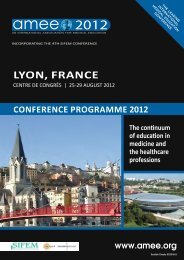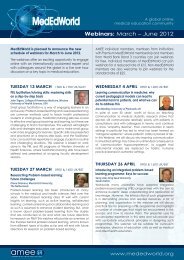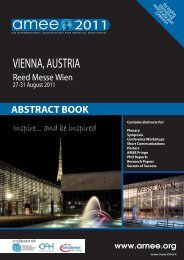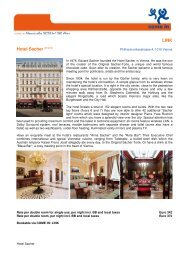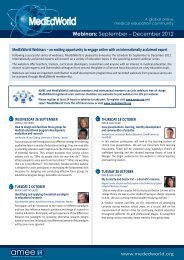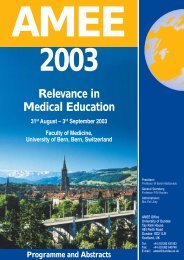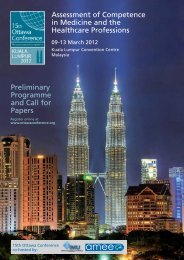AMEE Berlin 2002 Programme
AMEE Berlin 2002 Programme
AMEE Berlin 2002 Programme
Create successful ePaper yourself
Turn your PDF publications into a flip-book with our unique Google optimized e-Paper software.
0.05 - 0.13) to moderate (kappa: 0.51; 95% CI: 0.32 -<br />
0.70) between various pairs of examiners. Agreement<br />
between two endocrinologists assessing a case in<br />
endocrinology was only fair (kappa: 0.21; 95% CI:<br />
0.02-0.40). The results suggest unreliable (inter-rater)<br />
grading in written clinical case examinations.<br />
8D2 Identifying threshold competence<br />
in an undergraduate qualifying<br />
clinical examination<br />
John Cookson* and Stewart Petersen<br />
Leicester Warwick Medical School, Division of Medical<br />
Education, Faculty of Medicine, P O Box 138, Leicester LE1<br />
9HN, UK<br />
Undergraduate qualifying examinations seek to identify<br />
those who are competent to proceed to house officer<br />
training. This requires definition of the standard of<br />
competence required of the new graduate, and its<br />
conversion to a threshold within an examination. We<br />
have attempted to define the concept of the ‘minimally<br />
competent’ practitioner – one who is just able to<br />
proceed. The final professional clinical examination<br />
at LWMS is graded in terms of five ‘categories of<br />
competence’, with precise grade descriptors. We asked<br />
consultants who train house officers to define the<br />
minimally competent new graduate in terms of the<br />
proportions of patients where they would not perform<br />
satisfactorily in each category of competence.<br />
Proportions ranged from 0% to 50%. There was a clear<br />
tendency for history and examination skills to be<br />
considered more important. The findings have<br />
implications for setting examination thresholds.<br />
8D3 The validity of performance<br />
standards on a certification<br />
examination for occupational<br />
therapists<br />
Ernest Skakun<br />
Division of Studies in Medical Education, 2 J3000 WMC, Faculty<br />
of Medicine and Oral Health Sciences, University of Alberta,<br />
EDMONTON, Alberta, T6G 2R7, CANADA<br />
This study investigated the validity of passing scores<br />
set by the Nedelsky and Angoff methods for an<br />
occupational therapy national certification exam. Eight<br />
judges rendered Nedelsky and Angoff judgments for<br />
302 multiple choice items. Judges used a five-point<br />
scale to rate the competence of examinees selecting<br />
each alternative as an answer. Judges’ decisions were<br />
correlated with scores of examinees near the passing<br />
scores. Item difficulties were computed for examinees<br />
with scores just above (higher) and just below (lower)<br />
the passing scores for each method. The number of<br />
alternatives rated as “significant concerns about<br />
competence” and selected as possible answers was<br />
compared for higher and lower scoring examinees. The<br />
correlation between judges’ decisions and examinee<br />
scores around the passing score was 0.34 and 0.23 for<br />
the Angoff and Nedelsky methods respectively.<br />
Comparisons of proportion correct for higher and lower<br />
candidates showed more consistency for the Angoff<br />
method.<br />
Wednesday 5 September<br />
- 4.88 -<br />
8D4 Reliability of a sequential clinical<br />
examination<br />
Stewart Petersen* and John Cookson<br />
Leicester Warwick Medical School, Division of Medical<br />
Education, Faculty of Medicine, P O Box 138, Leicester LE1<br />
9HN, UK<br />
Clinical competence of students at Leicester Warwick<br />
Medical School is assessed by direct observation of<br />
consultations with a series of patients. Summative<br />
assessments are sequential. All students are observed<br />
with 2 or 4 patients, (depending on stage in the course),<br />
and those whose competence remains in doubt are<br />
observed with a further 3 or 4. In each consultation, a<br />
different pair of examiners observes students<br />
continuously. Examiners grade independently<br />
performance in five categories of competence defined<br />
by precise descriptors. There are precise grade<br />
descriptors. All examiners are trained. In a full, final<br />
examination, therefore, each student has 16 grades for<br />
each of five categories of competence. Analysis of data<br />
from three full cycles of assessment demonstrates that:<br />
(i) there is a high degree of inter-examiner reliability;<br />
(ii) eight cases are sufficient to mitigate case specificity;<br />
(iii) students vary in the relationship between<br />
performance in different categories of competence.<br />
8D5 Considerations of Legal, Ethical,<br />
Organizational Aspect of Clinical<br />
Competence in a National<br />
Licencing Examination, Evaluation<br />
at the Medical Council of Canada<br />
Jacques E. Des Marchais*, Dale W. Dauphinee and<br />
David Blackmore<br />
12420 rue Joseph-Edouard-Samson, Montreal Quebec H4K<br />
2N9, CANADA<br />
Organizations responsible for development and<br />
administration of national licensing examinations are<br />
becoming major partners in responding to evolution<br />
of emerging new social needs, such as Considerations<br />
of Legal, Ethical and Organizational aspects of medical<br />
practice(CLEO).The Medical Council of Canada<br />
(MCC) has been responsible for developing an<br />
examination process which leads to licensure to practise<br />
in the Canadian provinces. The study presents the<br />
decision-making process which has resulted in the<br />
development of the CLEO content of the Medical<br />
Council of Canada Qualifying Examination. The<br />
validation process of this new content is demonstrated<br />
as well as specific objectives in each of the three CLEO<br />
components. Results are presented from the first<br />
mandatory implementation, in May 2000, for about<br />
2000 candidates. Comparison with the MCQ scientific<br />
component is presented and discussed. Integration of<br />
CLEO disciplines into the second component (OSCE)<br />
of the MCC Qualifying examinations is also<br />
demonstrated.<br />
8D6 Combining different components of<br />
an assessment procedure<br />
J Degryse*, J Goedhuys, A Roex and A Dermine<br />
ACHG K U Leuven, Department of General Practice,<br />
Kapucijnenvoer 33 Blok J, B3000 Leuven, BELGIUM


